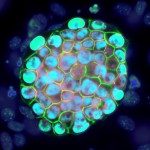Lien vers Pubmed [PMID] – 10366623
J. Neurosci. 1999 Jun;19(12):4889-98
The H-2Z1 transgene is restricted to a subset of layer IV neurons in the postnatal mouse cortex and delineates exactly the somatosensory area. Expression of the H-2Z1 transgene was used as an areal marker to determine when the parietal cortex becomes committed to a somatosensory identity. We have shown previously that grafts dissected from embryonic day 13.5 (E13.5) H-2Z1 cortex and transplanted into the cortex of nontransgenic newborns express H-2Z1 according to their site of origin. Expression was not modified on heterotopic transplantation (). In the present study, whole cortical explants were isolated at E12.5 from noncortical tissues. The explants developed a regionalized expression of H-2Z1, indicating that regionalization takes place and is maintained in vitro. We used this property and confronted embryonic H-2Z1 cortex with presumptive embryonic sources of regionalizing signals in an in vitro grafting procedure. A great majority of E11.5-E13.5 grafts maintained their presumptive expression of H-2Z1 when grafted heterotopically on nontransgenic E13.5-E15.5 explants. However, a significantly lower proportion of E11.5 parietal grafts expressed H-2Z1 in occipital compared with parietal cortex, indicating that somatosensory identity may be partially plastic at E11.5. Earlier stages could not be tested because the E10.5 grafts failed to develop in vitro. The data suggest that commitment to the expression of a somatosensory area-specific marker coincides with the onset of neurogenesis and occurs well before the birth of the non-GABAergic neurons that express H-2Z1 in vivo.

